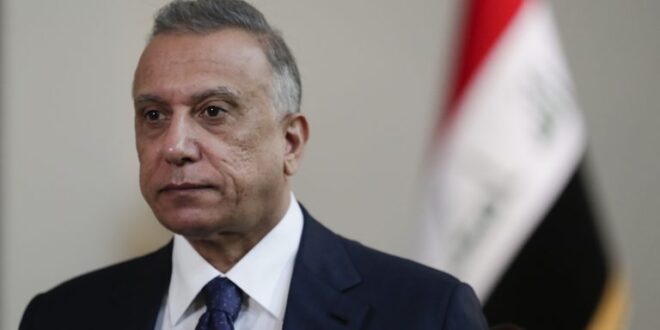The November 6 drone strike on Iraqi Prime Minister Mustafa al-Kadhimi’s home represented a dramatic escalation of violence over the results of Iraq’s October 10 national election.
The attack retaliated for the killing and wounding of pro-Iranian protesters by Iraqi security forces.
The assassination attempt, likely approved by Iran, illustrates Tehran’s increasing willingness to use military action against its regional adversaries.
The attack on the Prime Minister signaled a broad range of Iraqi factions that pro-Iranian groups must be well-represented in the government that will be selected by the new parliament.
On November 6, several armed drones struck the home of Iraq’s Prime Minister Mustafa al-Kadhimi, who, since taking office in 2020, has sought to balance the interests of the two major stakeholders in Iraq’s politics – the United States and the Islamic Republic of Iran. After the strike, which reportedly wounded several members of his security detail and inflicted some damage on his home in the heavily-fortified Green Zone, Kadhimi appeared on Iraqi television to appeal for calm and national unity. The attack came one day after supporters of Iran-backed militias, that operate independently of the national command structure, clashed with Iraqi security forces at the entrance to the Green Zone. One protester was killed and several were wounded, as were dozens of security officers, and the government has announced an investigation into the use of live fire against the protesters. The killing of a pro-Iranian protester on Friday appeared to represent, at least in part, motivation for the attack on Kadhimi.
The question of Iranian involvement in the assassination attempt is front and center for most analysts—Iran is known to have transferred armed drones to its allies in Iraq, particularly the Kata’ib Hezbollah militia. The militia has used Iran-supplied drones and other weaponry in recent attacks on bases used by U.S. military and intelligence personnel serving in Iraq. It is inconceivable, despite denials of responsibility by some high officials in Iran, that Kata’ib or any other Iran-backed faction would undertake as dramatic a step as a drone strike on the prime minister’s residence without Tehran’s explicit approval.
The assassination attempt and Green Zone clashes represent an escalation of violence produced by frustration among Iran-backed militia leaders over their relatively poor showing in Iraq’s October 10 election for the 329 seat National Assembly. According to Iraq’s political system, the newly-elected National Assembly is tasked with selecting a president, Prime Minister, and parliament speaker, and confirming a council of ministers. In the past, this process has taken several months of negotiations among major political blocs. According to official results, the Iran-backed militia factions, whose candidates banded together in the “Fatah Alliance,” lost more than half the seats they held in the previous Assembly. The Alliance has claimed that the election was fraudulent because the bloc gained more total votes than the faction that will emerge as the largest bloc in the next parliament – that of mercurial, nationalist, Shia cleric Moqtada Al Sadr. The Sadrists ably navigated the electoral district boundaries to engineer their significant victory in the election, despite a lower national vote total than their more pro-Iranian rivals.
Although election audits and reviews have corroborated the announced results, the Iran-backed groups, and their patrons in Tehran, appear to be trying to intimidate other Iraqi factions, including the Sadrists, to accommodate their interests in the upcoming government formation negotiations. First and foremost, Tehran and its Iraqi allies seek to oust Kadhimi from office, primarily for his insistence that U.S. forces retain at least an advisory presence in Iraq. Iran and its allies continue to agitate for the full expulsion of U.S. forces, in large part to avenge the Trump administration’s January 2020 strike that killed the charismatic and revered Islamic Revolutionary Guard Corps – Qods Force (IRGC-QF) commander Qasem Soleimani. The willingness of Iran and its Iraqi partners to use violence – to the point of attempting to assassinate Kadhimi – indicate that Tehran will spare no effort to ensure that a figure more to its liking replaces Kadhimi in negotiations over the prime ministerial selection. The drone attack also appears to confirm recent trends in which Iran has demonstrated a willingness to use armed action against its regional adversaries, as exemplified by the late October Iranian drone attack on a base in Syria used by U.S. forces. Moqtada Al Sadr, an erstwhile Iran ally turned nationalist, and someone who will be decisive in the negotiations on the next government, undoubtedly received the message from his former Iranian patrons that Tehran’s interests must be accommodated. Yet, it is possible that the assassination attempt could cause Iran’s opponents in Iraq, including not only Sadr but also the Sunni Arabs as well as the Kurds, to unite in order to limit Iran’s influence in Iraq going forward. It is also possible that the now violent power struggle could set Iraq back to its darkest days of civil strife in the several years following the 2003 U.S. invasion that toppled Saddam Hussein.
 Eurasia Press & News
Eurasia Press & News




